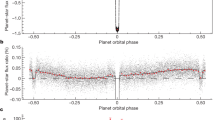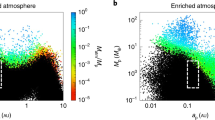Abstract
In the past decade, observations from space and the ground have found water to be the most abundant molecular species, after hydrogen, in the atmospheres of hot, gaseous extrasolar planets1,2,3,4,5. Being the main molecular carrier of oxygen, water is a tracer of the origin and the evolution mechanisms of planets. For temperate, terrestrial planets, the presence of water is of great importance as an indicator of habitable conditions. Being small and relatively cold, these planets and their atmospheres are the most challenging to observe, and therefore no atmospheric spectral signatures have so far been detected6. Super-Earths—planets lighter than ten Earth masses—around later-type stars may provide our first opportunity to study spectroscopically the characteristics of such planets, as they are best suited for transit observations. Here, we report the detection of a spectroscopic signature of water in the atmosphere of K2-18 b—a planet of eight Earth masses in the habitable zone of an M dwarf7—with high statistical confidence (Atmospheric Detectability Index5 = 5.0, ~3.6σ (refs. 8,9)). In addition, the derived mean molecular weight suggests an atmosphere still containing some hydrogen. The observations were recorded with the Hubble Space Telescope/Wide Field Camera 3 and analysed with our dedicated, publicly available, algorithms5,9. Although the suitability of M dwarfs to host habitable worlds is still under discussion10,11,12,13, K2-18 b offers an unprecedented opportunity to gain insight into the composition and climate of habitable-zone planets.
This is a preview of subscription content, access via your institution
Access options
Access Nature and 54 other Nature Portfolio journals
Get Nature+, our best-value online-access subscription
$29.99 / 30 days
cancel any time
Subscribe to this journal
Receive 12 digital issues and online access to articles
$119.00 per year
only $9.92 per issue
Buy this article
- Purchase on Springer Link
- Instant access to full article PDF
Prices may be subject to local taxes which are calculated during checkout



Similar content being viewed by others
Data availability
The data analysed in this work are available through the NASA MAST HST archive (https://archive.stsci.edu/) programmes 13665 and 14682. The molecular line lists used are available from the ExoMol website (www.exomol.com). The final and intermediate results (reduced data, extracted light curves, light curve fitting results and atmospheric fitting results) are available through the University College London Exoplanets website (https://www.ucl.ac.uk/exoplanets) and the Open Science Framework (OSF) website at https://doi.org/10.17605/OSF.IO/N7DQX.
Code availability
All the software used to produce the presented results are publicly available through the University College London Exoplanets GitHub website (https://github.com/ucl-exoplanets/). More specifically, the codes used were Tau-REx (https://github.com/ucl-exoplanets/TauREx_public), Iraclis (https://github.com/ucl-exoplanets/Iraclis) and PyLightcurve (https://github.com/ucl-exoplanets/pylightcurve).
Change history
25 September 2019
An amendment to this paper has been published and can be accessed via a link at the top of the paper.
References
Tinetti, G. et al. Infrared transmission spectra for extrasolar giant planets. Astrophys. J. Lett. 654, L99–L102 (2007).
Grillmair, C. J. et al. Strong water absorption in the dayside emission spectrum of the planet HD189733b. Nature 456, 767–769 (2008).
Fraine, J. et al. Water vapour absorption in the clear atmosphere of a Neptune-sized exoplanet. Nature 350, 64–67 (2015).
Macintosh, B. et al. Discovery and spectroscopy of the young jovian planet 51 Eri b with the Gemini Planet Imager. Science 456, 767–769 (2008).
Tsiaras, A. et al. A population study of gaseous exoplanets. Astron. J. 155, 156 (2018).
de Wit, J. et al. Atmospheric reconnaissance of the habitable-zone Earth-sized planets orbiting TRAPPIST-1. Nat. Astron. 2, 214–219 (2018).
Montet, B. T. et al. Stellar and planetary properties of K2 Campaign 1 candidates and validation of 17 planets, including a planet receiving Earth-like insolation. Astrophys. J. 809, 25 (2015).
Benneke, B. & Seager, S. How to distinguish between cloudy mini-Neptunes and water/volatile-dominated super-Earths. Astrophys. J. 778, 153 (2013).
Waldmann, I. P. et al. Tau-REx I: a next generation retrieval code for exoplanetary atmospheres. Astrophys. J. 802, 107 (2015).
Segura, A. et al. Biosignatures from Earth-like planets around M dwarfs. Astrobiology 5, 706–725 (2005).
Wordsworth, R. D. et al. Gliese 581d is the first discovered terrestrial-mass exoplanet in the habitable zone. Astrophys. J. 733, L48 (2011).
Leconte, J. et al. 3D climate modeling of close-in land planets: circulation patterns, climate moist bistability, and habitability. Astron. Astrophys. 554, A69 (2013).
Turbet, M. et al. The habitability of Proxima Centauri B. II. Possible climates and observability. Astron. Astrophys. 596, A112 (2016).
Deming, D. et al. Infrared transmission spectroscopy of the exoplanets HD 209458b and XO-1b using the Wide Field Camera-3 on the Hubble Space Telescope. Astrophys. J. 774, 95 (2013).
Kreidberg, L. et al. Clouds in the atmosphere of the super-Earth exoplanet GJ1214b. Nature 505, 69–72 (2014).
Knutson, H. A. et al. Hubble Space Telescope near-IR transmission spectroscopy of the super-Earth HD 97658b. Astrophys. J. 794, 155 (2014).
Tsiaras, A. et al. Detection of an atmosphere around the super-Earth 55 Cancri e. Astrophys. J. 820, 99 (2016).
Wakeford, H. R. et al. Disentangling the planet from the star in late-type M dwarfs: a case study of TRAPPIST-1g. Astron. J. 157, 11 (2019).
Benneke, B. et al. Spitzer observations confirm and rescue the habitable-zone super-Earth K2-18b for future characterization. Astrophys. J. 834, 187 (2017).
Kopparapu, R. K. A revised estimate of the occurrence rate of terrestrial planets in the habitable zones around Kepler M-dwarfs. Astrophys. J. Lett. 767, L8 (2013).
Valencia, D., Tan, V. Y. Y. & Zajac, Z. Habitability from tidally induced tectonics. Astrophys. J. 857, 106 (2018).
Cloutier, R. et al. Characterization of the K2-18 multi-planetary system with HARPS. A habitable zone super-Earth and discovery of a second, warm super-Earth on a non-coplanar orbit. Astron. Astrophys. 608, A35 (2017).
Valencia, D., Guillot, T., Parmentier, V. & Freedman, R. S. Bulk composition of GJ 1214b and other sub-Neptune exoplanets. Astrophys. J. 775, 10 (2013).
Zeng, L., Sasselov, D. D. & Jacobsen, S. B. Mass–radius relation for rocky planets based on PREM. Astrophys. J. 819, 127 (2016).
Tsiaras, A. et al. A new approach to analyzing HST spatial scans: the transmission spectrum of HD 209458 b. Astrophys. J. 832, 202 (2016).
Eastman, J. et al. Achieving better than 1 minute accuracy in the heliocentric and barycentric Julian dates. Publ. Astron. Soc. Pac. 122, 935 (2010).
Waldmann, I. P. et al. Tau-REx II: retrieval of emission spectra. Astrophys. J. 813, 13 (2015).
Tennyson, J. et al. The ExoMol database: molecular line lists for exoplanet and other hot atmospheres. J. Mol. Spec. 327, 73–94 (2016).
Tinetti, G. et al. A chemical survey of exoplanets with ARIEL. Exp. Astron. 46, 135–209 (2018).
Allard, F., Homeier, D. & Freytag, B. Models of very-low-mass stars, brown dwarfs and exoplanets. Philos. Trans. R. Soc. A 370, 2765–2777 (2012).
Claret, A. A new non-linear limb-darkening law for LTE stellar atmosphere models. Calculations for −5.0 < = log[M/H] < = +1, 2000 K < = T eff < = 50000 K at several surface gravities. Astron. Astrophys. 363, 1081–1190 (2000).
Kreidberg, L. et al. A detection of water in the transmission spectrum of the hot Jupiter WASP-12b and implications for its atmospheric composition. Astrophys. J. 814, 66 (2015).
Evans, T. M. et al. Detection of H2O and evidence for TiO/VO in an ultra-hot exoplanet atmosphere. Astrophys. J. Lett. 822, L4 (2016).
Line, M. R. et al. No thermal inversion and a solar water abundance for the hot Jupiter HD 209458b from HST/WFC3 spectroscopy. Astron. J. 152, 203 (2016).
Wakeford, H. R. et al. HST PanCET program: a cloudy atmosphere for the promising JWST target WASP-101b. Astrophys. J. Lett. 835, L12 (2017).
McCullough, P. & MacKenty, J. Considerations for Using Spatial Scans with WFC3 Instrument Science Report WFC3 2012-08 (STSI, 2012).
Sarkis, P. et al. The CARMENES search for exoplanets around M dwarfs: a low-mass planet in the temperate zone of the nearby K2-18. Astron. J. 155, 257 (2018).
Rackham, B. V., Apai, D. & Giampapa, M. S. The transit light source effect: false spectral features and incorrect densities for M-dwarf transiting planets. Astrophys. J. 853, 122 (2018).
Skilling, J. Nested sampling for general Bayesian computation. Bayesian Anal. 1, 833–860 (2006).
Feroz, F., Hobson, M. P. & Bridges, M. MULTINEST: an efficient and robust Bayesian inference tool for cosmology and particle physics. Mon. Not. R. Astron. Soc. 398, 1601–1614 (2009).
Barber, R. J., Tennyson, J., Harris, G. J. & Tolchenov, R. N. A high-accuracy computed water line list. Mon. Not. R. Astron. Soc. 368, 1087–1094 (2006).
Rothman, L. S. et al. HITEMP, the high-temperature molecular spectroscopic database. J. Quant. Spec. Rad. Transf. 111, 2139–2150 (2010).
Yurchenko, S. N. & Tennyson, J. ExoMol line lists—IV. the rotation–vibration spectrum of methane up to 1500 K. Mon. Not. R. Astron. Soc. 440, 1649–1661 (2014).
Yurchenko, S. N., Barber, R. J. & Tennyson, J. A variationally computed line list for hot NH3. Mon. Not. R. Astron. Soc. 413, 1828–1834 (2011).
Foreman-Mackey, D. corner.py: scatterplot matrices in Python. J. Open Source Softw. 24, 1 (2016).
Acknowledgements
This project has received funding from the European Research Council (ERC) under the European Union’s Horizon 2020 research and innovation programme (grant agreements 758892, ExoAI; 776403/ExoplANETS A) and under the European Union’s Seventh Framework Programme (FP7/2007-2013)/ERC grant agreement numbers 617119 (ExoLights) and 267219 (ExoMol). We further acknowledge funding by the Science and Technology Funding Council (STFC) grants ST/K502406/1 and ST/P000282/1. The data used here were obtained by the Hubble Space Telescope as part of the 13665 and 14682 GO proposals (PI: B. Benneke).
Author information
Authors and Affiliations
Contributions
A.T. performed the data analysis and developed the HST analysis software Iraclis; I.P.W. developed the atmospheric retrieval software Tau-REx; G.T. contributed to the interpretation of the results; J.T. and S.N.Y. coordinated the ExoMol project. All authors discussed the results and commented on the manuscript.
Corresponding authors
Ethics declarations
Competing interests
The authors declare no competing interests.
Additional information
Publisher’s note Springer Nature remains neutral with regard to jurisdictional claims in published maps and institutional affiliations.
Supplementary information
Supplementary tables and figures
Supplementary Tables 1–4 and Supplementary Figs. 1–21.
Rights and permissions
About this article
Cite this article
Tsiaras, A., Waldmann, I.P., Tinetti, G. et al. Water vapour in the atmosphere of the habitable-zone eight-Earth-mass planet K2-18 b. Nat Astron 3, 1086–1091 (2019). https://doi.org/10.1038/s41550-019-0878-9
Received:
Accepted:
Published:
Issue Date:
DOI: https://doi.org/10.1038/s41550-019-0878-9
This article is cited by
-
Optical properties of organic haze analogues in water-rich exoplanet atmospheres observable with JWST
Nature Astronomy (2023)
-
Dynamics and clouds in planetary atmospheres from telescopic observations
The Astronomy and Astrophysics Review (2023)
-
Detecting molecules in Ariel low resolution transmission spectra
Experimental Astronomy (2023)
-
RAPOC: The Rosseland and Planck opacity converter
Experimental Astronomy (2023)
-
Methane as a dominant absorber in the habitable-zone sub-Neptune K2-18 b
Nature Astronomy (2022)



